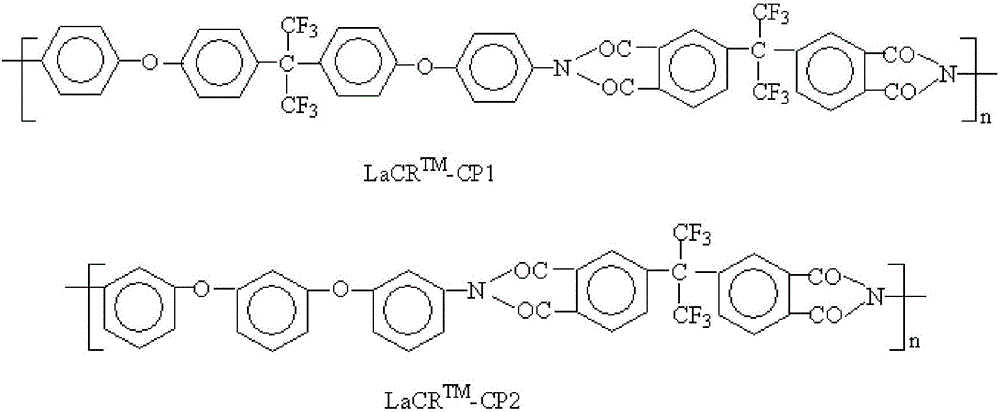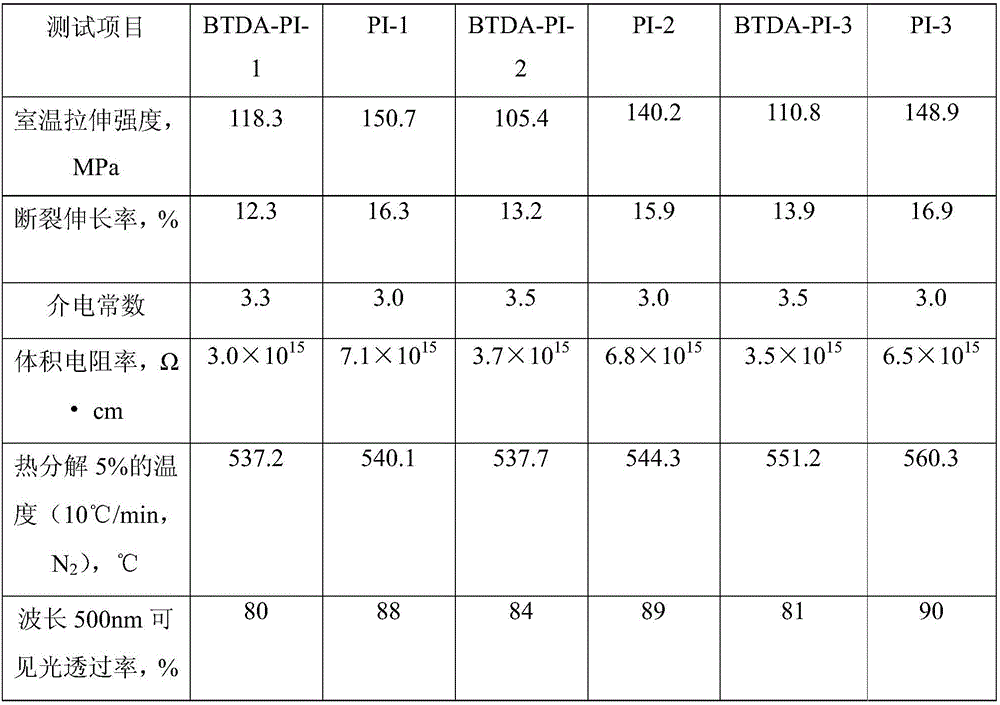BTDA type BDADTBHQ branched polyimide resin thin film and preparation method thereof
A technology of polyimide resin and polyamic acid resin, which is applied in the field of polyimide film and its preparation, can solve the problem that it is difficult to obtain high molecular weight polyimide resin, the comprehensive performance of film products is reduced, and the cost of film products is reduced. Advanced problems, to achieve the effect of excellent dimensional stability, significant comprehensive performance superiority, excellent electrical properties and optical properties
- Summary
- Abstract
- Description
- Claims
- Application Information
AI Technical Summary
Problems solved by technology
Method used
Image
Examples
Embodiment 1
[0035] 160.0 grams (0.8 moles) of 4,4'-diaminodiphenyl ether (44ODA), 19.8 grams (0.1 moles) of 4,4'-diaminodiphenylmethane, 22.4 grams (0.1 moles) of 2-(4-amino Phenyl)-5-aminobenzimidazole (APABI) and 1600 grams of N-methyl-2-pyrrolidone (NMP) were added to the polymerization bottle, stirred at room temperature, after completely dissolving, cooled in an ice-water bath to below 5°C, and added 325.2 Gram (1.01 mole) 3,3',4,4'-tetracarboxylic benzophenone dianhydride (BTDA), stirred, reacted at 5°C for 1 hour, and obtained 2127.4 grams of homogeneous, transparent, viscous BTDA type The polyamic acid resin solution is referred to as BTDA-PAA-1. The Brookfield CAP2000+ vertebral plate viscometer was used to measure the viscosity, and the performance data are shown in Table 1.
Embodiment 2
[0037] 146.0 grams (0.5 moles) of 1,3-bis(4-aminophenoxy)benzene (134BAPB), 19.8 grams (0.1 moles) of 4,4'-diaminodiphenylmethane, 43.2 grams (0.4 moles) of p-benzene Add diamine (PPDA), 1000 grams of N,N-dimethylacetamide (DMAc) and 1180 grams of N-methyl-2-pyrrolidone (NMP) into the polymerization bottle, stir at room temperature, and cool in an ice-water bath after completely dissolving To below 5°C, add 338.1 g (1.05 moles) of 3,3',4,4'-tetracarboxylic benzophenone dianhydride (BTDA), stir, and react at 8°C for 3 hours to obtain 2727.1 g of homogeneous, transparent , Viscous BTDA type polyamic acid resin solution, denoted as BTDA-PAA-2. The Brookfield CAP2000+ vertebral plate viscometer was used to measure the viscosity, and the performance data are shown in Table 1.
Embodiment 3
[0039] Add 200.0 g (1.0 mole) of 4,4'-diaminodiphenyl ether (DADPE) and 3280 g of N-methyl-2-pyrrolidone (NMP) into the polymerization bottle, stir at room temperature, and cool in an ice-water bath after completely dissolving To below 5°C, add 347.8 g (1.08 moles) of 3,3',4,4'-tetracarboxylic benzophenone dianhydride (BTDA), stir, and react at 10°C for 6 hours to obtain 3827.8 g of homogeneous, transparent , viscous BTDA type polyamic acid resin solution, denoted as BTDA-PAA-3. The Brookfield CAP2000+ vertebral plate viscometer was used to measure the viscosity, and the performance data are shown in Table 1.
PUM
 Login to View More
Login to View More Abstract
Description
Claims
Application Information
 Login to View More
Login to View More - R&D
- Intellectual Property
- Life Sciences
- Materials
- Tech Scout
- Unparalleled Data Quality
- Higher Quality Content
- 60% Fewer Hallucinations
Browse by: Latest US Patents, China's latest patents, Technical Efficacy Thesaurus, Application Domain, Technology Topic, Popular Technical Reports.
© 2025 PatSnap. All rights reserved.Legal|Privacy policy|Modern Slavery Act Transparency Statement|Sitemap|About US| Contact US: help@patsnap.com



